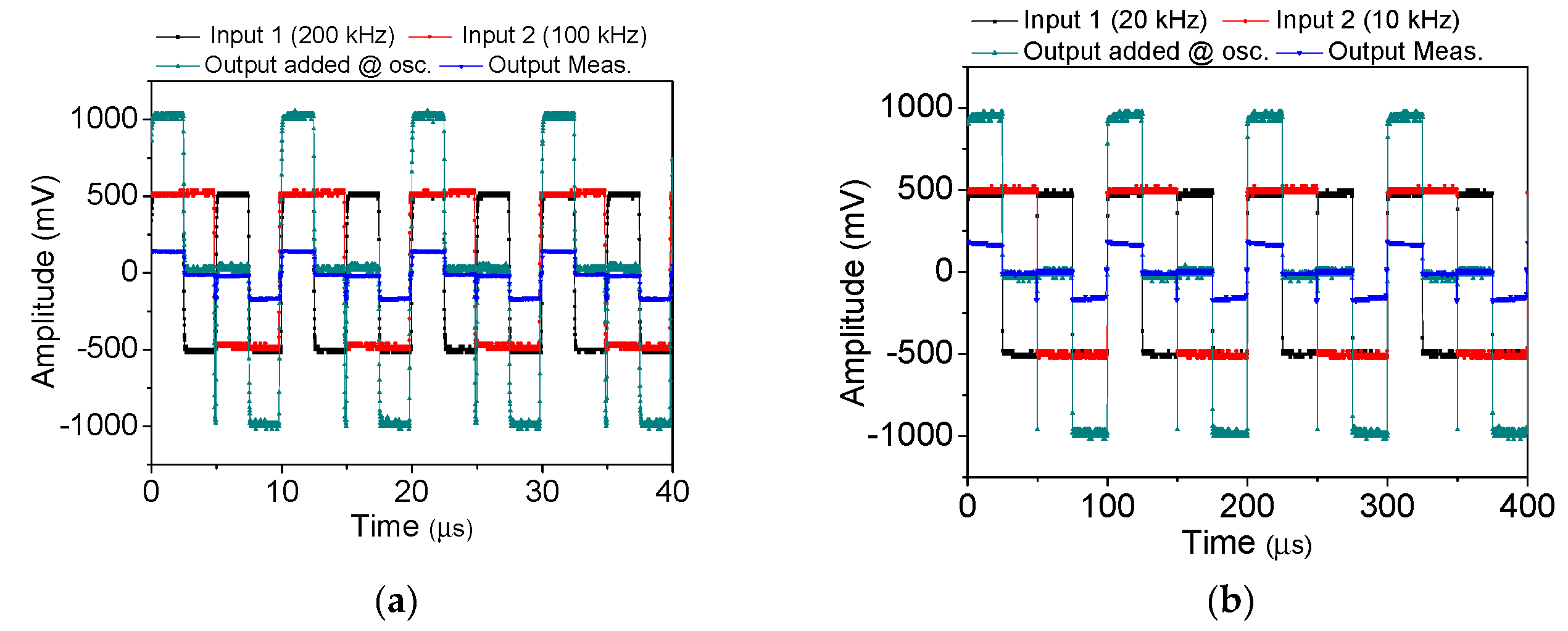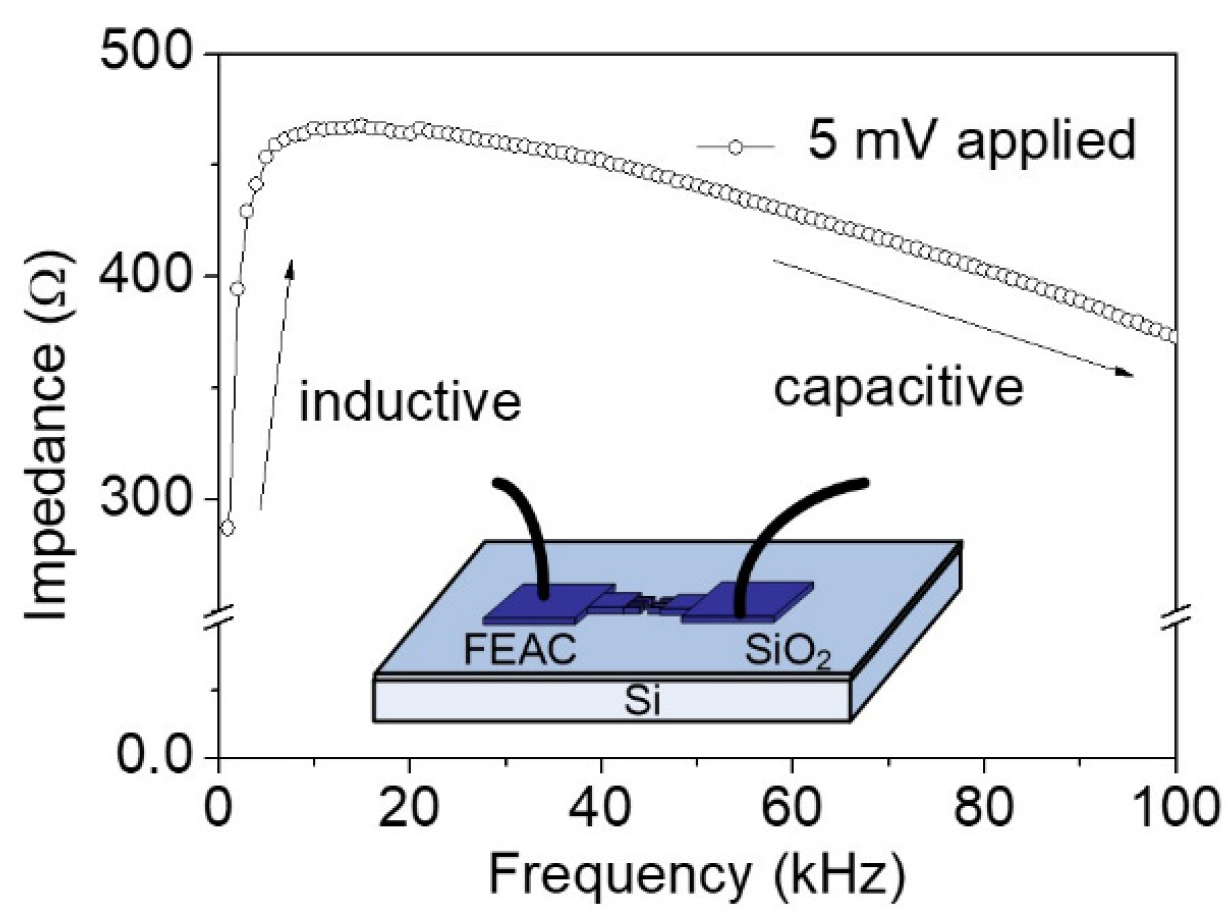Field Emission Air-Channel Devices as a Voltage Adder
Abstract
:1. Introduction
2. Experiments
2.1. Fabrication of FEAC Devices
2.2. Measurement Setup as a Voltage Adder
2.3. Finite Element Modeling
3. Results and Discussion
3.1. Field Emission Properties of the FEAC Devices
3.2. Application of the FEAC Devices as a Voltage Adder
3.3. Frequency-Dependent Equivalent Circuit
3.4. Finite Element Modeling of the FEAC
4. Conclusions
Author Contributions
Funding
Acknowledgments
Conflicts of Interest
References
- Choi, W.B.; Chung, D.S.; Kang, J.H.; Kim, H.Y.; Jin, Y.W.; Han, I.T.; Lee, Y.H.; Jung, J.E.N.; Lee, S.; Park, G.S.; et al. Fully sealed, high-brightness carbon-nanotube field-emission display. Appl. Phys. Lett. 1999, 75, 3129–3131. [Google Scholar] [CrossRef] [Green Version]
- Send, S.; Tanemura, M.; Sakai, Y.; Ichikawa, Y.; Kita, S.; Otsuka, T.; Okuyama, F. New field-emission x-ray radiography system. Rev. Sci. Instrum. 2004, 75, 1366–1368. [Google Scholar] [CrossRef]
- Hsu, S.H.; Kang, W.P.; Davidson, J.L.; Huang, J.H.; Kerns, D.V. Nanodiamond vacuum field emission integrated differential amplifier. IEEE Trans. Electron. Devices 2013, 60, 487–492. [Google Scholar] [CrossRef]
- Ghosh, N.; Kang, W.P.; Davidson, J.L. Fabrication and implementation of nanodiamond lateral field emission diode for logic OR function. Diam. Relat. Mater. 2012, 23, 120–124. [Google Scholar] [CrossRef]
- Chang, W.T.; Chuang, T.Y.; Su, C.W. Metal-based asymmetric field emission diodes operated in the air. Microelectron. Eng. 2020, 232, 111418. [Google Scholar] [CrossRef]
- Subramanian, K.; Kang, W.P.; Davidson, J.L.; Ghosh, N.; Galloway, K.F. A review of recent results on diamond vacuum lateral field emission device operation in radiation environments. Microelectron. Eng. 2011, 88, 2924–2929. [Google Scholar] [CrossRef]
- Hsu, H.; Kang, W.P.; Raina, S.; Huang, J.H. Nanodiamond vacuum field emission device with gate modulated triode characteristics. Appl. Phys. Lett. 2013, 102, 203105. [Google Scholar] [CrossRef]
- Han, J.W.; Oh, J.S.; Meyyappan, M. Cofabrication of vacuum field emission transistor (VFET) and MOSFET. IEEE Trans. Nanotechnol. 2014, 13, 464–468. [Google Scholar] [CrossRef]
- Wong, T.K.S.; Ingram, S.G. Observational of Fowler-Nordheim tunnelling at atmospheric pressure using Au/Ti lateral tunnel diodes. J. Phys. D Appl. Phys. 1993, 26, 979–985. [Google Scholar] [CrossRef]
- Pescini, L.; Tilke, A.; Blick, R.H.; Lorenz, H.; Kotthaus, J.P.; Eberhardt, W.; Kern, D. Nanoscale lateral field-emission triode operating at atmospheric pressure. Adv. Mater. 2001, 13, 1780–1783. [Google Scholar] [CrossRef]
- Srisonphan, S.; Jung, Y.S.; Kim, H.K. Metal–oxide–semiconductor field-effect transistor with a vacuum channel. Nat. Nanotechnol. 2012, 7, 504–508. [Google Scholar] [CrossRef] [PubMed]
- Han, J.W.; Moon, D.I.; Meyyappan, M. Nanoscale vacuum channel transistor. Nano Lett. 2017, 17, 2146–2151. [Google Scholar] [CrossRef] [PubMed]
- Liu, M.; Fu, W.; Yang, Y.; Li, T.; Wang, Y. Excellent field emission properties of VO2(A) nanogap emitters in air. Appl. Phys. Lett. 2018, 112, 093104. [Google Scholar] [CrossRef]
- Jones, W.M.; Lukin, D.; Scherer, A. Practical nanoscale field emission devices for integrated circuits. Appl. Phys. Lett. 2017, 110, 263101. [Google Scholar] [CrossRef]
- Nirantar, S.; Ahmed, T.; Ren, G.; Gutruf, P.; Xu, C.; Bhaskaran, M.; Walia, S.; Sriram, S. Metal–air transistors: Semiconductor-free field-emission air-channel nanoelectronics. Nano Lett. 2018, 18, 7478–7484. [Google Scholar] [CrossRef]
- Chang, W.T.; Pao, P.H. Field electrons intercepted by coplanar gates in nanoscale air channel. IEEE Trans. Electron. Devices 2019, 66, 3961–3966. [Google Scholar] [CrossRef]
- Aptea, A.; Joshi, P.; Bhaskar, P.; Joag, D.; Kulkarni, S. Vertically aligned self-assembled gold nanorods as low turn-on, stable field emitters. Appl. Surf. Sci. 2015, 355, 978–983. [Google Scholar] [CrossRef]
- Fowler, R.H.; Nordheim, L. Electron emission in intense electric fields. Proc. R. Soc. Lond. A 1928, 119, 173–181. [Google Scholar]
- Strayer, R.W.; Mackie, W.; Swanson, L.W. Work function measurements by the field emission retarding potential method. Surf. Sci. 1973, 34, 225–248. [Google Scholar] [CrossRef]
- Barnes, S.C.; Singer, K.E. A field-emission retarding-potential device for absolute work function measurements. J. Phys. E Sci. Instrum. 1977, 10, 737–740. [Google Scholar] [CrossRef]
- Chemistry Reference- Tantalum. Available online: http://chemistry-reference.com/q_elements.asp?Symbol=Ta (accessed on 10 November 2020).
- Norris, W.T. Work function of the (110) face of tantalum in a cesium vapor. J. Appl. Phys. 1964, 35, 467–469. [Google Scholar] [CrossRef]
- Tsagarakis, M.S.; Xanthakis, J.P. A 3-dimensional calculation of the field emission current and emission angle of a vacuum transistor as a function of gate voltage and radius of curvature of the emitter. AIP Adv. 2019, 9, 105314. [Google Scholar] [CrossRef]
- Ji, Z.; Zhang, G.; Li, Y.; Wei, J.; Xing, Y.; Yang, J.; Zhou, W. Field emission behaviors under trapezoid voltage pulses with a DC bias. Vacuum 2019, 172, 109045. [Google Scholar] [CrossRef]
- Tománek, D.; Louie, S.G.; Mamin, H.J.; Abraham, D.W.; Thomson, R.E.; Ganz, E.; Clarke, J. Theory and observation of highly asymmetric atomic structure in scanning-tunneling-microscopy images of graphite. Phys. Rev. B 1987, 35, 7790–7793. [Google Scholar] [CrossRef] [PubMed]
- Seo, E.; Choi, B.K.; Kim, O. Determination of proximity effect parameters and the shape bias parameter in electron beam lithography. Microelectron. Eng. 2000, 53, 305–308. [Google Scholar] [CrossRef]
- Ji, S.; Piazza, L.; Cao, G.; Park, S.T.; Reed, B.W.; Masiel, D.J.; Weissenrieder, J. Influence of cathode geometry on electron dynamics in an ultrafast electron microscope. Struct. Dyn. 2017, 4, 054303. [Google Scholar] [CrossRef]
- Ikuno, T.; Okamoto, H.; Sugiyama, Y.; Nakano, H.F.; Yamada, H.I.; Kamiya, H. Electron transport properties of Si nanosheets: Transition from direct tunneling to Fowler-Nordheim tunneling. Appl. Phys. Lett. 2011, 99, 023107. [Google Scholar] [CrossRef]
- Lenzlinger, M.; Snow, E.H. Fowler Nordheim tunneling into thermally grown SiO2. J. Appl. Phys. 1969, 40, 278–283. [Google Scholar] [CrossRef]
- Smith, R.C.; Forrest, R.D.; Carey, J.D.; Hsu, W.K.; Silva, S.R.P. Interpretation of enhancement factor in nonplanar field emitters. Appl. Phys. Lett. 2005, 87, 013111. [Google Scholar] [CrossRef] [Green Version]
- de Assis, T.A. Improving the extraction of characteristic field enhancement factors from nonlinear Fowler–Nordheim plots: Call for experimental tests. J. Vac. Sci. Technol. B 2015, 33, 052201. [Google Scholar] [CrossRef]
- Koenigsfeld, N.; Kalish, R.; Cimmino, A.; Hoxley, D.; Prawer, S. Effect of surface roughness on field emission from chemical vapor deposited polycrystalline diamond. Appl. Phys. Lett. 2001, 79, 1288. [Google Scholar] [CrossRef]
- Liu, H.; Saito, Y. Influence of surface roughness on field emission of electrons from carbon nanotube films. J. Nanosci. Nanotechnol. 2010, 10, 3983–3987. [Google Scholar] [CrossRef] [PubMed]
- Desal, P.D.; Chu, T.K.; James, H.M.; Ho, C.Y. Electrical resistivity of selected elements. J. Phys. Chem. Ref. Data 1984, 13, 1069–1096. [Google Scholar]












Publisher’s Note: MDPI stays neutral with regard to jurisdictional claims in published maps and institutional affiliations. |
© 2020 by the authors. Licensee MDPI, Basel, Switzerland. This article is an open access article distributed under the terms and conditions of the Creative Commons Attribution (CC BY) license (http://creativecommons.org/licenses/by/4.0/).
Share and Cite
Chang, W.-T.; Cheng, M.-C.; Chuang, T.-Y.; Tsai, M.-Y. Field Emission Air-Channel Devices as a Voltage Adder. Nanomaterials 2020, 10, 2378. https://doi.org/10.3390/nano10122378
Chang W-T, Cheng M-C, Chuang T-Y, Tsai M-Y. Field Emission Air-Channel Devices as a Voltage Adder. Nanomaterials. 2020; 10(12):2378. https://doi.org/10.3390/nano10122378
Chicago/Turabian StyleChang, Wen-Teng, Ming-Chih Cheng, Tsung-Ying Chuang, and Ming-Yen Tsai. 2020. "Field Emission Air-Channel Devices as a Voltage Adder" Nanomaterials 10, no. 12: 2378. https://doi.org/10.3390/nano10122378




